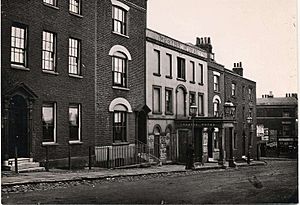Sarah Baker (18th-century actress) facts for kids
Sarah Baker (born around 1736 or 1737 – died 20 February 1816) was a famous English actress and theatre manager. She worked in the county of Kent for over 50 years. Even though she couldn't read or write, she was very good at business. She became one of the most successful women of her time who built her own career.
Contents
Early Life and Performances
Sarah Baker was born Sarah Wakelin in a town called Milton, Kent. Her mother, Ann Wakelin, was an amazing dancer and managed a group of performers. This group, called "Mrs. Wakelin's Company," performed at the Sadler's Wells Theatre. Sarah's father, James Wakelin, was an actor. He later opened a bookshop where he sold religious books.
Sarah and her sister Mary started performing as dancers in their mother's company. They performed at Sadler's Wells and then traveled to other cities like Norwich, Great Yarmouth, and Bristol. Sarah also put on puppet shows. Her mother's company often got fined for their shows. These shows included exciting acts like rope-dancing, puppet shows, and pantomimes.
Starting Her Own Company
Sarah married Thomas Baker in 1760. He was an acrobat in her mother's performing group. Sadly, Thomas died in 1769, leaving Sarah with three young children: Anne, Henry, and Sally. To take care of her family, Sarah took over managing her mother's company from 1772 to 1777.
Her company put on shows with "rope-dancing, tumbling, music, and new costumes." They traveled all over Kent, performing in towns like Dover, Canterbury, Rochester, and Tunbridge Wells. Many of her family members, including her mother and children, were part of the acting group. Sarah also hired popular performers, like the clown Lewy Owen. They performed plays and funny pantomimes, where Sarah's daughter, Sarah, often played the character of Columbine.
Becoming a Theatre Manager
When her mother retired in 1777, Sarah Baker started her own touring company. She performed plays by famous writers like William Shakespeare and Richard Brinsley Sheridan. She also continued to offer fun fairground acts and variety shows. Many actors who later became famous, like Edmund Kean and Joseph Grimaldi, started their careers with Sarah Baker. They liked working for her because she paid them regularly.
As her company grew, she could attract even more famous performers. These included singers like Charles Incledon and actors like Dorothea Jordan. Joseph Grimaldi, a very famous clown, performed with her in Rochester in 1801. Her company performed many Shakespeare plays, such as Hamlet, Macbeth, and The Merchant of Venice. They also put on funny operas and local plays like The Merry Hop-Pickers.
At first, Sarah used a theatre that could be moved from town to town. Sometimes, she would use any suitable building for her shows. But around 1789, she started building her own permanent theatres. She eventually owned ten theatres in towns like Hastings, Tunbridge Wells, Maidstone, and Canterbury. Each theatre had a place for her performers to stay, which was good and cheap.
Sarah was very careful with money. She designed her theatres so that one ticket booth covered all the entrances. This helped her keep a close eye on the money coming in. In 1815, she passed the management of her successful company to her son-in-law, William Dowton.
Death and Lasting Impact

The famous writer Charles Dickens lived in Rochester when he was a boy. He visited the Theatre Royal often. Later, he wrote about it in his books The Uncommercial Traveller and The Mystery of Edwin Drood. Some people believe that Sarah Baker and her theatre inspired Dickens's interest in acting and writing. There is a special plaque on the building that now stands where the theatre was, remembering Dickens.
Sarah Baker died in her home in Rochester in February 1816. Her home was right next to the Theatre Royal she had built. She was buried in the churchyard at Rochester Cathedral. In her will, she left a lot of money and property, showing how successful she had become.


